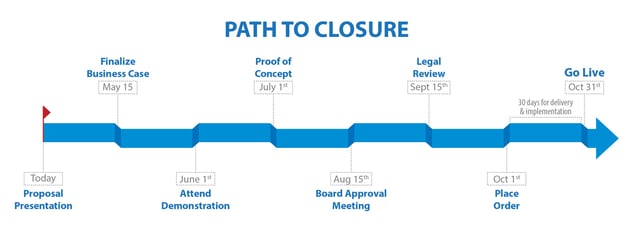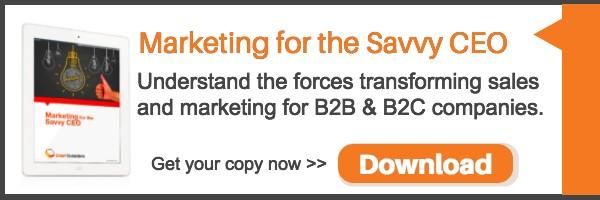CEO Blog - Advice for CEOs on growth and scaling
Take the “Path to Closure” to Ensure Forecast Accuracy Success

 Only a half a generation ago, we thought we had it made, technology-wise. Getting onto the World Wide Web was as easy as loading up the latest CD mailer from America Online; and we were able to send important messages to beeping little black boxes that resided on our belt clip or purse strap. We truly had it made – or so we thought.
Only a half a generation ago, we thought we had it made, technology-wise. Getting onto the World Wide Web was as easy as loading up the latest CD mailer from America Online; and we were able to send important messages to beeping little black boxes that resided on our belt clip or purse strap. We truly had it made – or so we thought.
Today, pagers and AOL are the stuff of nostalgia – but, so, too, are what we considered to be the “standard” ways of operating a business. Consequently, there have been some seismic changes rattling the foundation of our sales forecasting process.
Those of us old enough to have shoved that AOL disk into our Gateway PC might also remember the two traditional models of sales forecasting – the “weighted pipeline” and the “forecast categories.” Both were used abundantly in business planning; but both, as we know, were far from perfect.
With the weighted pipeline, we were invariably projecting based off of little more than judgment when it came to amounts, closing dates, and closing probabilities. This approach was also dependent upon discarding the reality of “all or nothing” situations in B2B transactions— you either sell the entire amount projected, or you sell nothing at all. The one real benefit to the weighted pipeline, is that it is a method that allows for easy projection.
Forecast categories represented a slightly better approach, but still fell far short. Again, because “judgment” was a significant part of the recipe, it was prone to errors in judgment when it came to amounts and closing dates.
Every CEO I have ever met yearns to have predicable and sustainable revenue growth. Part of achieving this is directly related to a mastery of the sales forecasting process. Whereas win/loss reviews are critical to drive productivity and win-rate, forecasting is all about understanding the timing and momentum of a deal. This all begs the question: Wouldn’t it be nice to be able to better predict when you’d be able to close a sale?
Fortunately, I pioneered an approach, borne of a past frustration, which may solve this dilemma. I call it “Path to Closure,” and, when I developed it while working at Xerox Canada, my goal was to create a process that could be employed by any member of the sales force. Though my approach may bear some similarities to a technique called “Reverse Timelines,” whatever its called, it captures the process and timing from the prospect’s point of view.
Indeed, with “Path to Closure,” it’s the prospect’s voice that is of the utmost importance. To successfully project outcomes in this manner, we must determine what a prospect needs to happen, and in what timeframe, in order to close the deal. Understanding the timing of a deal is particularly critical, because other approaches tend to ignore this dimension.
This advantage, in fact, puts you on the “path” to gauging a prospect’s engagement and interest in closing the sale, instead of relying upon an assumption or inference on the sales rep’s behalf. Not only does it capture the client’s input, in his or her own words and processes, but it also helps to indicate the stage of the deal. By considering the prospect’s deadline in this manner, it can help sales reps to recalibrate their expectations, and act accordingly.
With “Path to Closure,” I typically teach salespeople to work backwards. A conversation might go something like this:
Salesperson: So I can provide better support during your decision process, I’d like to understand what has to happen between now and your desired delivery or “go” date. When do you think you’ll be up and running?
Prospect: October 31st.
(By having them disclose the date, we have an anchor point, and understand what the customer perceives as the desired go-live date)
Salesperson: Is there any particular significance behind that date?
(Asking this question can provide insight on how critical is it to be up and running by then. Reps should draw a horizontal line on a piece of paper with the date October 31st at the end of it, writing the words “GO LIVE” under the date. This line will serve as your timeline.)
Salesperson continues: So, if you want to be live by the 31st, we will need a signed agreement by October 1st, since we need 30 days for implementation. Does that work for you?
Prospect: Yes, it does.
Salesperson: Can we clarify all of the activities that have to take place within your company to arrive at an agreement? Can I ask if this decision has to be approved by your board? If so, when is the date of the board meeting?
(If they provide a date, write it on the timeline.)
Salesperson continues: What else has to happen? (Ask as many questions as you have to in order to determine what has to happen for the decision to be made and implemented.)
The key benefits of “Path to Closure” are the following:
- The rep and client mutually understand the key dates, and can collaborate together on the go-forward plan.
- The rep clearly understands when the client expects the solution to be fully implemented.
- The sales cycle is more likely to be kept on track, and the sales rep can consult the document during follow-up calls.
- Forecasting is better and more accurate.
For a complete visual reference of the Path of Closure, consult the diagram below.

It is my hope that by using the “Path to Closure,” your sales efforts will be crisp, robust – and perpetually relevant. In this manner, you can ensure your sales efforts sparkle and shine like the latest iPhone 7 – rather than fester in a junk drawer with yesterday’s flip phone.
For more on how you can improve your sales efficacy, read Karen Hayward’s blog about “Enabling the Sale.”
Topics: Sales Strategy, Sales Enablement, Sales Funnel
Tue, Jan 17, 2017Featured Chief Outsider
/cmo-Karen-Hayward.jpg?width=200&height=200&name=cmo-Karen-Hayward.jpg)
Karen Hayward
- Press Releases
- Careers
- Case Studies
- Marketing Consultant Company
- Marketing Strategy Consultants
- Marketing Plan Consultants
- B2B Marketing Consultants
- Virtual CMO
- Marketing Consultant Outsourcing
- Fractional CMO
- What is a Fractional CMO
- Healthcare Marketing Consultant
- Marketing Consultant Houston TX Texas
- Marketing Consultant Texas TX
- Marketing Consultant Bay Area
- CEO Blog
- Ebooks Plus
- Executive Marketing Consultants
- Product Marketing Consultants
- B2C Marketing Consultants
- Virtual Marketing Consultants
- Senior Marketing Consultants
- Temporary CMO
- Hire a CMO
- Fractional CMO Salary
- Fractional CMO Responsibilities
- Marketing Consultant Austin TX Texas
- Marketing Consultant Dallas TX Texas
- Marketing Consultant San Antonio
- Helping Private Equity
- Private Equity Blog
- Leadership Team
- Privacy Policy
- Business Marketing Consultants
- Strategic Marketing Consultants
- Marketing Technology Consultants
- Sales and Marketing Consultants
- CMO Job Description
- CMO Salary
- Fractional CMO Agency
- Fractional CMO Services
- CPG Marketing Consultant
- Marketing Consultant San Diego
- Partners
Houston, TX 77056
© 2023 Chief Outsiders



